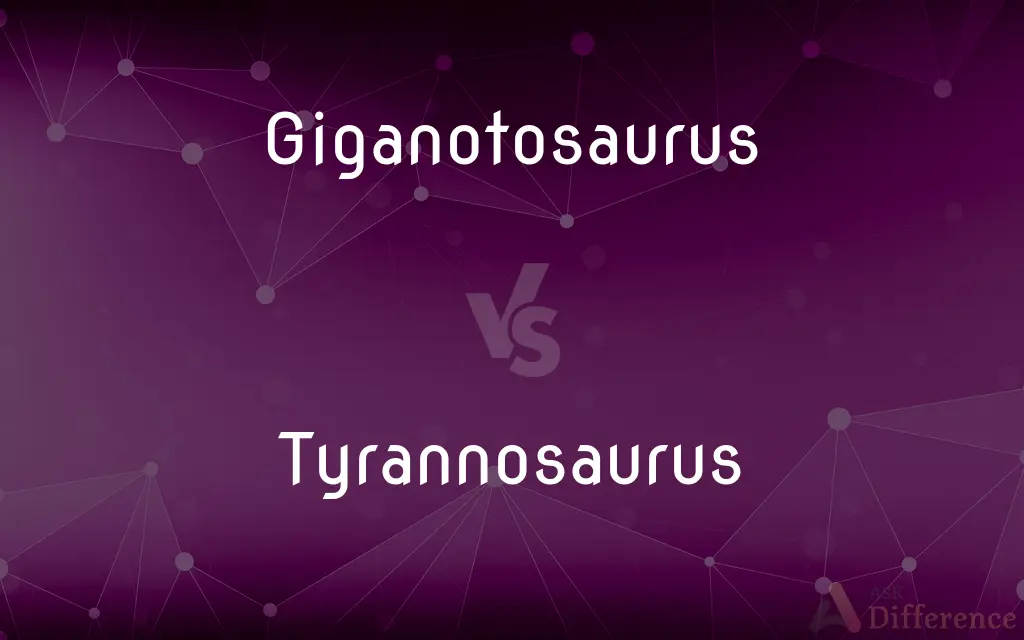Giganotosaurus vs. Tyrannosaurus — What's the Difference?
By Tayyaba Rehman — Updated on September 21, 2023
Giganotosaurus is a large theropod dinosaur from the Late Cretaceous period found in South America, while Tyrannosaurus is a similarly sized theropod from the Late Cretaceous period but native to North America.

Difference Between Giganotosaurus and Tyrannosaurus
Table of Contents
ADVERTISEMENT
Key Differences
Giganotosaurus and Tyrannosaurus are both giant theropod dinosaurs that roamed Earth during the Late Cretaceous period. While Giganotosaurus is known primarily from fossils found in Argentina, Tyrannosaurus is famously associated with North America.
In terms of size, both Giganotosaurus and Tyrannosaurus are among the largest carnivorous dinosaurs. However, recent evidence suggests that Giganotosaurus might have been slightly larger than the Tyrannosaurus, but with a lighter build.
The skulls of the Giganotosaurus and Tyrannosaurus show distinct differences. While the Tyrannosaurus had a stout and deep skull equipped with thick teeth, Giganotosaurus had a narrower skull with slender teeth, hinting at differences in their prey and hunting techniques.
Giganotosaurus's arms were relatively longer than those of Tyrannosaurus, which had notably short arms. Still, both predators primarily used their powerful jaws as their main weapon.
Though both these predators lived during the Late Cretaceous period, they didn't coexist in time or place. Giganotosaurus lived a few million years earlier and on a separate continent from the Tyrannosaurus.
ADVERTISEMENT
Comparison Chart
Geographical Location
South America (Argentina)
North America
Estimated Size
Possibly slightly larger than Tyrannosaurus
Slightly smaller than Giganotosaurus
Skull Structure
Narrower with slender teeth
Stout and deep with thick teeth
Arm Length
Relatively longer arms
Notably short arms
Time of Existence
Earlier in the Late Cretaceous period
Later in the Late Cretaceous period
Compare with Definitions
Giganotosaurus
Large theropod from South America
The Giganotosaurus is among the largest dinosaurs found in Argentina.
Tyrannosaurus
North American predator
Tyrannosaurus fossils are predominantly found in North America.
Giganotosaurus
Late Cretaceous carnivore
The Giganotosaurus thrived millions of years before the end of the dinosaur era.
Tyrannosaurus
Powerful bite force
The Tyrannosaurus had one of the strongest bite forces among all terrestrial animals.
Giganotosaurus
Narrow-skulled predator
The Giganotosaurus had a slender skull, indicating it might have hunted differently than some of its contemporaries.
Tyrannosaurus
Late Cretaceous apex predator
Near the end of the age of dinosaurs, Tyrannosaurus reigned supreme.
Giganotosaurus
Known from Argentina
The fossil evidence for Giganotosaurus primarily comes from Argentina.
Tyrannosaurus
Iconic large theropod
The Tyrannosaurus is one of the most recognized dinosaurs in popular culture.
Giganotosaurus
Gigantic carnivorous dinosaur
Few predators rivaled the size and power of the Giganotosaurus during its time.
Tyrannosaurus
Short-armed carnivore
Despite its tiny arms, the Tyrannosaurus was a formidable hunter.
Giganotosaurus
Giganotosaurus ( JY-gə-NOH-tə-SOR-əs) is a genus of theropod dinosaur that lived in what is now Argentina, during the early Cenomanian age of the Late Cretaceous period, approximately 99.6 to 97 million years ago. The holotype specimen was discovered in the Candeleros Formation of Patagonia in 1993, and is almost 70% complete.
Tyrannosaurus
Tyrannosaurus is a genus of tyrannosaurid theropod dinosaur. The species Tyrannosaurus rex (rex meaning "king" in Latin), often called T. rex or colloquially T-Rex, is one of the best represented of these large theropods.
Giganotosaurus
A very large carnivorous theropod dinosaur of the genus Giganotosaurus of the Cretaceous Period, having a massive skull and large teeth.
Tyrannosaurus
Any of various tyrannosaurid dinosaurs of the genus Tyrannosaurus, having a large head and teeth and short forelimbs, and including T. rex and possibly some other species. Also called tyrannosaur.
Giganotosaurus
Any of several very large, carnivorous dinosaurs of the subfamily Giganotosaurinae, from the Cretaceous period.
Tyrannosaurus
See T. rex.
Tyrannosaurus
A large carnivorous dinosaur, of the genus Tyrannosaurus, found in North America during the late Cretaceous period.
Tyrannosaurus
Large carnivorous bipedal dinosaur having enormous teeth with knifelike serrations; may have been a scavenger rather than an active predator; later Cretaceous period in North America
Common Curiosities
Where was Giganotosaurus found?
Giganotosaurus fossils were primarily discovered in Argentina.
Which dinosaur had a stronger bite, Giganotosaurus or Tyrannosaurus?
Tyrannosaurus is believed to have had one of the strongest bite forces of any land animal.
Which was faster, Giganotosaurus or Tyrannosaurus?
It's hard to determine exact speeds, but both were likely fast for their size.
Why did Tyrannosaurus have such short arms?
The exact reason is debated, but they might have been used for holding prey or assisting in getting up from a prone position.
How were the hunting techniques of Giganotosaurus and Tyrannosaurus different?
Differences in skull and tooth structure suggest varied hunting and feeding methods, but exact techniques are speculative.
Was Tyrannosaurus the largest dinosaur?
No, while Tyrannosaurus was large, some dinosaurs like Giganotosaurus and Spinosaurus might have been larger.
Did Giganotosaurus and Tyrannosaurus ever meet?
No, they existed at different times and on different continents.
Which had a longer lifespan, Giganotosaurus or Tyrannosaurus?
It's challenging to determine exact lifespans, but estimates suggest both lived into their late twenties or early thirties.
Did either Giganotosaurus or Tyrannosaurus have feathers?
Some evidence suggests that Tyrannosaurus had filament-like structures, but it's uncertain for Giganotosaurus.
Were Giganotosaurus and Tyrannosaurus related?
Both were theropods, but they belonged to different families and lineages.
How do we know about the diets of Giganotosaurus and Tyrannosaurus?
Fossilized remains, tooth structure, and comparison to modern animals help infer their diets.
Were there other dinosaurs similar to Giganotosaurus and Tyrannosaurus?
Yes, many theropods existed, like Allosaurus or Carcharodontosaurus, which had similarities.
Share Your Discovery

Previous Comparison
Sheriff vs. Cop
Next Comparison
Ivermectin vs. AvermectinAuthor Spotlight
Written by
Tayyaba RehmanTayyaba Rehman is a distinguished writer, currently serving as a primary contributor to askdifference.com. As a researcher in semantics and etymology, Tayyaba's passion for the complexity of languages and their distinctions has found a perfect home on the platform. Tayyaba delves into the intricacies of language, distinguishing between commonly confused words and phrases, thereby providing clarity for readers worldwide.














































